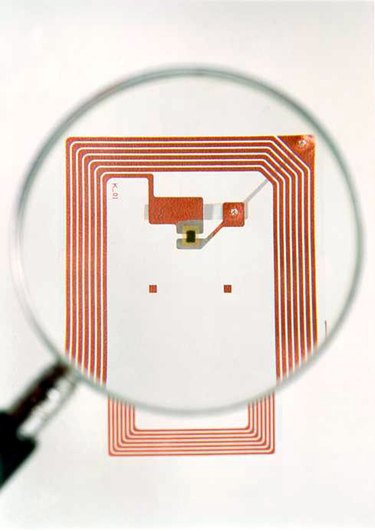
Radio-frequency identification, or RFID, uses radio waves to transfer data from a RFID tag to a transceiver. RFID tags vary in size and complexity, from tiny passive tags that draw their power from the reader and have a range of a few centimeters, to larger active tags that have an onboard battery and a range up to 100 meters. Due to their low costs and the ability to read tags from a distance, RFID tags are finding their way into everything from product packaging to passports.
How Does RFID Work?
Video of the Day
RFID Systems use an antenna to transmit radio-frequency signals from a transceiver to local RFID tags. The RF signal activates the tags, and allows them to transmit their stored information back to the reader. Many RFID tags are read only, and hold no data other than a unique identifier. The actual data about the object corresponding to the RFID tag is stored in an external database, referenced by the unique identifier from the tag. Some advanced RFID tags can store small amounts of data, which the transceiver can update as required.
Video of the Day
Passive RFID Tags
Passive RFID tags are the most widely used tags, due to their low cost and small size. Passive tags draw their power from the RF signal from the transceiver, so require no battery and can operate for many years. As passive tags require no onboard power source, modern technology allows tags to be as small as a grain of rice or as thin as a sheet of paper, allowing easy embedding into credit cards, labels and passports. Due to their small size and limited power, passive tags must be close to the transceiver for reading to occur, ranging from a few centimeters for tags operating on the 125 KHz frequency, up to six meters for larger tags operating on higher frequencies.
Active RFID Tags
Active RFID tags work along the same principle as passive tags, but include their own power supply, typically a battery. This allows active tags to produce stronger RF signals, which can travel over a greater distance to the transceiver. Active tags typically use higher frequencies in the 850Mhz – 950Mhz frequency range and above, and can transmit over distances of 100 meters. Due to their onboard battery, active tags are larger and more noticeable than passive tags, and are more expensive to produce. As such, active tags are commonly used for tracking large and expensive items, such as railway freight cars as they pass through a station. Unlike passive tags, active tags require periodic maintenance to ensure they have enough power to operate.
Disrupting RFID tags
Many people are concerned about the privacy issues concerning RFID tags, as their primary use is for tracking. In reality, these fears are often unfounded, as private data is usually not stored on the tag itself, and it is difficult to read passive tags from a distance. There are a number of methods discussed on the Internet for disabling RFID chips, such as using a strong magnet to destroy the tag. This is ineffective, as RFID tags do not use magnetic based memory, and the tags are typically too small to induce enough power to damage the chip. In reality, the only way to kill the chip is by physically destroying it by cutting through the chip, or blasting it with a high voltage or microwaves. The easiest solution, which is non-permanent and does not damage the tag or attached object, is to make or purchase a RF shielding wallet to stop a third party from reading the tag without permission.